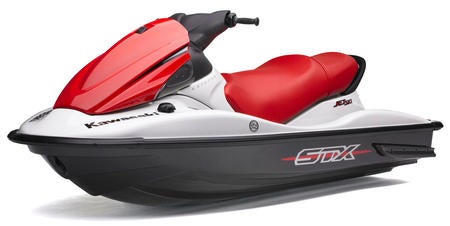2010 Kawasaki Jet Ski STX Review
Kawasaki gives entry-level a little more oomph
Once upon a time, the lowest entry-level models were kind of like Rodney Dangerfield: they didn’t get much respect. Basically they were destined for rental fleets. Then the economy tanked, and people began to give them a second look.
Most, like Kawasaki’s STX, deserve the second chance.
Cheap Power
Yes, the STX is bare bones as you might expect. It lacks reverse, something that pays big dividends in close quarters, or when trying to smoothly dock. It also lacks a boarding ladder; fall off and you’ll just have to haul yourself aboard by a grab handle. There are no rearview mirrors. (That last one isn’t actually that much of a tradeoff, as I’ve never found any PWC mirror to be all that useful.)
The STX does, however, get something that many bare-bones “entries” lack — full instrumentation. You get a speedo, fuel gauge, all the necessary info to help you successfully get through a ride.
 No other entry level craft can boast the type of power offered by the STX.
No other entry level craft can boast the type of power offered by the STX.You also get power, and more of it than the average lowest guy on the totem pole. Like all PWC manufacturers, Kawi has an engine that handles the brunt of the work load, in this case a 1,498cc, dual-overhead cam four-cylinder that cranks out 160 hp. That’s 50 more horses than Yamaha’s entry-level candidate, and 30 more than Sea-Doo’s. And yes, you do feel the difference on the water. It’s got a sweet low-end punch that delivers some acceleration thrills, but a punch that will also help get skiers up and out of deep water with greater success. Top speed maxes out in the lower 60s, also a notch above the competition.
Too much power for pure newbies? I don’t think so. For years I’ve argued that this is an engine that will allow the rider to grow with the boat, rather than quickly outgrow it. The power is not overwhelming, but it’s there for when your skill set improves and you want to do a little more with it.
Get ‘Er Done
The STX hull may be starting to show its age aesthetically, but it does its job on the water. Before the big Ultras came into play, this was essentially the design Kawasaki pilots used on the racecourse. It’s quick and agile handling, able to provide the stability beginners demand, but also crank a hard corner and allow the driver to push their limits when the time is right. Again, the engine comes into play; having the added power increases the boat’s handling ability, as riders can punch the throttle to power out of a corner.
 Seating position on the STX is a little low. Whether this is good or bad comes down to personal preference.
Seating position on the STX is a little low. Whether this is good or bad comes down to personal preference.The seating position, though improved slightly over the years, remains slightly low. Some will like the close-to-the-water feeling it provides; others may feel slightly cramped atop the seat. This is a preference issue, so again, try and get a test drive.
One nice thing about the ergonomics is that I’ve always been comfortable sitting or standing atop the STX. The handlebar angle is fixed, but it doesn’t get in the way when you need to stretch your legs. The ride is also mostly dry, a result of splash-deflecting ridges molded into the hull.
The STX maintains features like off-throttle steering. Essentially it boosts engine rpm when the engine computer senses a release in the throttle coupled with a sharp turn at the handlebars. The goal, of course, is to return some directional control and help panicked riders avoid a collision by returning a little bit of thrust at the pump. A magnetic key system is used for securing the craft from unwanted use. A second key will limit overall speed, which is a nice feature for when getting the kids up to speed as drivers or turning over the craft to a novice friend.
Deal or No Deal
My only real hesitation on the STX in 2010 is that the price has increased $600 to $8,499. No, that’s not horrendous, but I liked when Kawasaki had a price that only sealed the deal. Now, it will make potential customers have to seriously consider Yamaha’s VX Sport and Sea-Doo’s GTI 130 (both only $7,999).
Each will have its fans. But for those who want to keep the most money possible in their pocket (or in the gas tank), and yet still get a ride and power delivery a notch above the basic, the STX makes a compelling case for itself.
And offers a pretty good ratio of fun for the dollar.
| Kawasaki Jet Ski STX Specs | |
| Length | 122.8 inches |
| Beam | 46.5 inches |
| Curb Weight | 833.5 lbs |
| Engine | Four-cylinder DOHC EFI |
| Displacement | 1,498 cc |
| Bore and Stroke | 83mm x 69.2mm |
| Compression Ratio | 10.6:1 |
| Rated Horsepower | 160 |
| Fuel Capacity | 16.4 gal. |
| Combined Stowage Capacity | 23.5 gal. |
| Colors | Jet White/Firecracker Red |
| Price | $8,499 |
Related Reading
2010 Kawasaki Jet Ski STX-15F Review
2010 Kawasaki Jet Ski Ultra LX Review
2010 Kawasaki Jet Ski Ultra 260LX Review
2010 Kawasaki Jet Ski Ultra 260X Review
2010 Sea-Doo GTI 130 Review
Inside Yamaha’s 2010 VX Deluxe
Get PersonalWatercraft.com in your Inbox!
Like PersonalWatercraft.com on Facebook
Comments
Most Popular

2025 Yamaha JetBlaster PRO 2-Up Review

Remembering the Sea-Doo XP

2024 Kawasaki Jet Ski STX 160X Review

2017 Kawasaki Jet Ski Ultra 310LX Review

Whatever Happened to the Wetbike?













 Your Privacy Choices
Your Privacy Choices